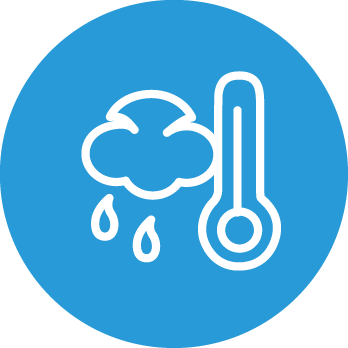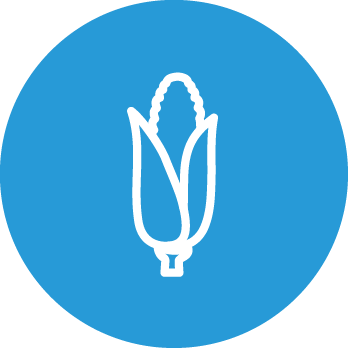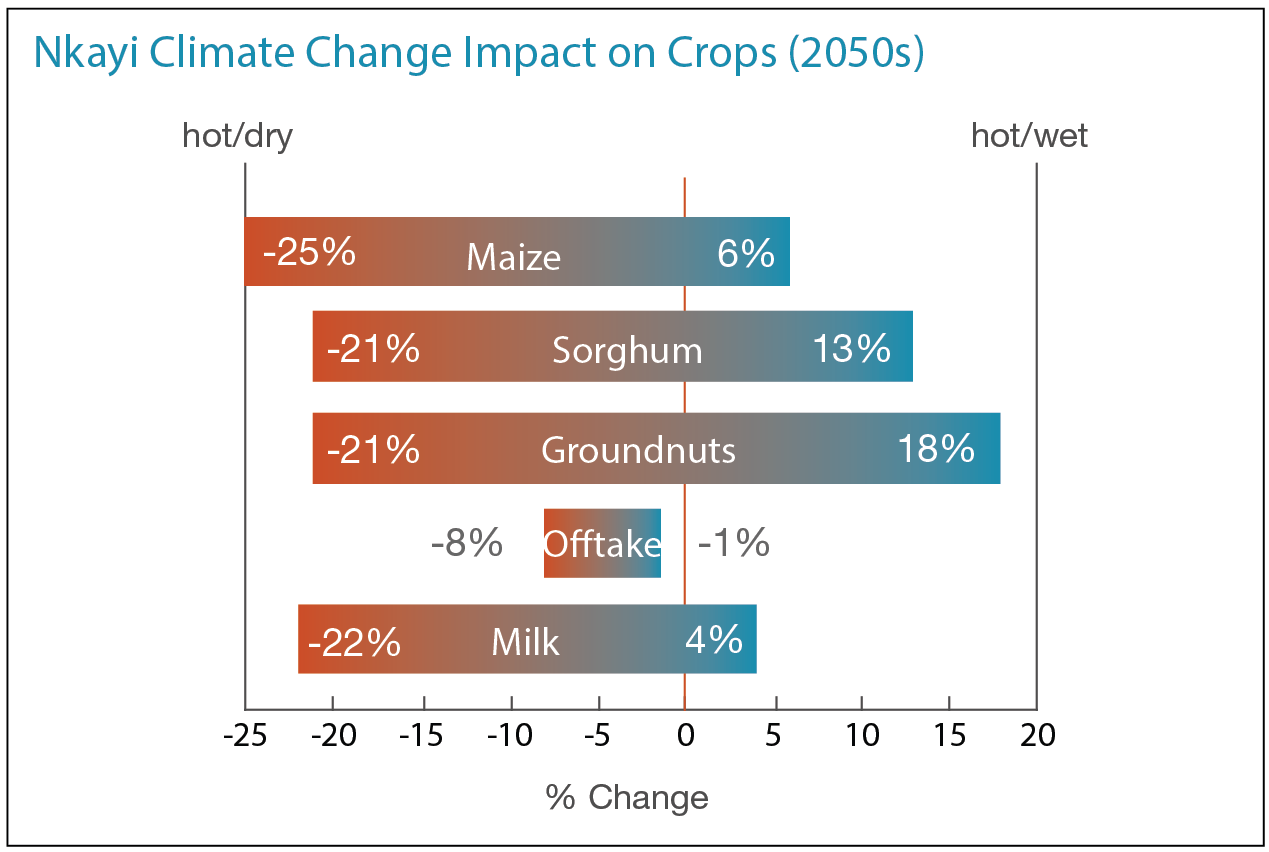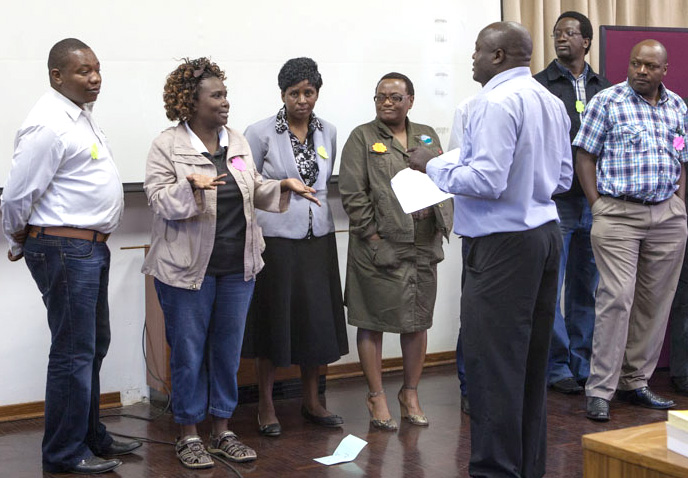Nkayi, Zimbabwe
Adapting smallholder rain-fed farming systems

Current Farming System
Smallholder farms
Rain fed
Maize, Groundnuts, Sorghum
75% have Livestock
Low soil fertility
Semi-arid
High Food Insecurity

CLIMATE 2050s
Increase in temperatures up to 3°C.
Precipitation changes are variable: a decrease by about 25% is possible

Impacts
Rangelands will produce less feed for livestock, lowering productivity
Groundnuts as cultivated today, in most cases can benefit from climate change
Maize and sorghum productivity, already low, stays the same

VULNERABILITY 2050s
70% of current farming households are vulnerable to climate change
Farms with higher stocking density would be more at risk

CURRENT INTERVENTIONS
Targeted improved management practices could increase farm yields from 130% to 400%
93% of farms would benefit from improved fertilizer, legume production, and markets
 Results Overview
Results Overview
Nkayi, Zimbabwe, a poor rural district in Natural Region IV, is a predominantly rainfed agricultural region. Farmers remain vulnerable to climate change, as low and variable rainfall (<650 mm annually) and regular droughts (every 2 of 5 years) make production difficult. Poverty in the region is already the highest in the country: more than 76% of the rural population lives below the poverty line (<1.5 USD per day), and more than 22% is extremely poor (living <1USD per day) (ZimVac, 2013). Food self-sufficiency varies from 3 to 10 months depending on the annual rainfall, leaving rural households extremely vulnerable to the adverse effects of climate change.

Location of study region
Nkayi farms are predominately maize and cattle producing farms. All farmers grow maize and approximately two-thirds also keep cattle. Cattle keepers typically maintain slightly better lives than maize-only farmers, though both struggle with poverty. The region is highly vulnerable. 95% of the very poor without cattle live below the poverty line, 90% of the less poor with small cattle herds live below the poverty line, and still 60% of the better off population is below the poverty line. Cattle breeding farmers are mostly less vulnerable, given that they typically cultivate more land, intensify and diversify alternative crops, and earn more off-farm income than maize-only farmers.
Climate change is projected to negatively impact farmers in Nkayi. If farm and socio-economic practices from today do not change in the future, a rising temperature of 3°C and 25% decreased rainfall could leave up to 70% of households exposed to greater vulnerability. Aggregately, this number does not appear to differ from current conditions. However, the most threatened population changes from the maize farmers (today) to cattle farmers (in future). Climate change will mostly affect larger cattle herders (83% vulnerable) and small cattle herders (73%). The very poor will be less effected (65% vulnerable), though already they live under extreme levels of vulnerability. Livestock farmers are negatively impacted most because the drier climate affects livestock fodder, milk production and farms with higher stocking density.
By implementing improved management practices, farmers can increase crop yields by over 200%. Reconfiguring farms, improving cereal management could increase farm net returns from 308 and 1627 USD to 657 and 2258 USD, for the extremely poor and those with large herds respectively. Converting land beyond food self sufficiency in maize to more profitable and climate resilient crops, such as groundnuts and fodder legumes, could increase their farm net returns to 1125 and 2936 USD, respectively. Improving groundnut markets would increase the net returns to 1489 and 3566 USD, respectively. Groundnuts are an opportunity to increase income for the poorest. Farms with cattle could improve livestock production via better feed quality from crop residues and higher quantities of nutritious forages.
In areas where improved management practices may be adopted, climate change impacts on cereals and groundnuts can be negated. Most farms will have ease to switch to cereal varieties with longer life cycles and groundnut losses from climate can be reversed by implementing drought tolerant strands. Climate effects on livestock could be buffered by supplementing locally produced feed with commercial stock feed. Impacts, particularly on nutrition and gender, are greater under sustainable development pathways compared to fast economic growth, especially for the extremely poor. This is esp.
 Farming System
Farming System

Cattle grazing on farm in Zimbabwe
Farming systems in Nkayi are cattle-maize dominated (Homann-Kee Tui et al., 2015). Crop and livestock production are fairly integrated – crop residue is the key feed resource for livestock during the dry season and livestock draft power and manure are important services to crop production. In Nkayi, all farmers cultivate maize, about one third produce groundnuts, and one third produce small grains.
Current crop yield levels in Nkayi are extremely low, similar to the national average. Maize yields fluctuate around 0.7 tons per hectare, sorghum around 0.5 tons per hectare, and groundnuts around 0.4 tons per hectare. Historically, maize yields attained up to 1 ton per hectare in communal lands and 4.5 tons per hectare in sector; sorghum and groundnuts yields commonly reached up to 2.5 tons per hectare in the commercial sector (Ministry of Agriculture, 2007).
Manure and fertilizer application is limited to maize. Approximately one third of farmers apply an average of 470kg/ha of manure to their lands, while less than a fifth apply an average of 10kg/ha of inorganic fertilizer (Homann-Kee Tui et al., 2013).
About 60% of the households keep cattle and/or goats and donkeys, which they use mainly as a source of draft power and organic fertilizer, as well as cash income. Livestock productivity is also low, evidenced by high mortality rates that can be more than 15%, low milk yields (<1.5 liters per cow per day) and offtake rates of less than 10%. Despite dry season feed shortages and poor feed quality, less than 5% of farmers produce forages, and crop residues are the most common source of supplementary feed.
The Nkayi district is characterized by low and erratic rainfall, hit by frequent droughts and intra-seasonal dry spells. The situation is worse in Nkayi district than the rest of Zimbabwe because poor soil fertility status and limited agricultural input use results in low productivity. Statistics show that this district already has the highest poverty prevalence in Zimbabwe. About 76% of all rural households in Zimbabwe are poor and more than 22% are extremely poor (ZimVAC, 2013). Food self-sufficiency varies from 3 to 10 months depending on the annual rainfall, leaving rural households extremely vulnerable to the adverse effects of climate change (Homann-Kee Tui et al., 2013). Heterogeneity in the farming community is high and three farm types are distinguished, (1) extremely poor households with no cattle, cultivating 1.5 ha on average, (2) poor households with 0 to 8 cattle, cultivating 2 ha, (3) better-off households with more than 8 cattle, cultivating 2.7 ha.
Farmers focus crop management on maize. Alternative crops, small grains, and legumes are underdeveloped. Slightly more farmers grow legumes than small grains, but the area sizes of legumes are very small. Net returns of alternative crops are higher than those of maize; yet maize is the most traded commodity in this high risk and food insecure farming context. Overall, the contribution of these alternative crops to overall farm net returns is very low as few farmers grow these crops. The alternative crops and other ruminants therefore help little to buffer climate change impacts on the main activities, maize and cattle.
 Climate Change Projections
Climate Change Projections

Median changes in June-September growing season (left) temperature (oC) and (right) total precipitation (mm) from 29 climate model simulations for Zimbabwe and surrounding countries in South Africa in the 2050s under a high emissions climate change scenario, compared with the 1980-2010 historical period.
Although projected changes in temperature vary depending on the Global Climate Model (GCM) and Representative Concentration Pathway (RCP) used, minimum and maximum temperatures are consistently increasing over the region. This increase is consistent across model and scenarios used. In all models, the temperature increases more the further into the future, and also demonstrates similar increases independent of season and month.Unlike temperature, rainfall projections are inconsistent across GCMs. Models project positive and negative changes in precipitation and there is high variability in projected amplitude changes. The balance of GCMs suggests a small decrease in precipitation, though confidence is low. This uncertainty makes it important for all rainfall scenarios to be considered when projecting climate change impacts. Though there is no significance to date, there is an observed change in seasonal distribution, a regular decrease of the rainy season onset month. This decrease in rainy season's onset month total precipitation may be caused by the delayed onset, but could also be from a reduction in intensity or frequency. This has still yet to be determined.
 Climate Change Impacts
Climate Change Impacts

Results of crop model projections for the 2050s under a high emissions scenario.
Current System
Sensitivity of crops to individual climate factors (temperature, CO2) show that an increase in temperature would reduce crop production while an increase in CO2 concentration would slightly increase cereal crop production and substantially increase legume production. The responses to the combined climate factors vary for different crops. Cereal crops, such as sorghum and maize, will most likely decrease in both grain and stover production under hot scenarios. Legumes, such as groundnuts and mucuna, will most likely increase in yield under all scenarios. Legume yields will be driven by the positive impacts of increased CO2 concentrations (which will outweigh the negative increased temperature impacts) The life cycle of all crops will also be affected. Days to maturity will reduce, and the life cycle will shorten more with warmer scenarios. These impacts, however, will be insignificant if the low soil fertility and currently low productivity of land is not addressed.
The current system was assessed via two crop models. These crop models analyzed the impacts climate change will have on maize, sorghum, and groundnuts. Three soils, with varying levels of organic carbon and water holding capacity, were used for the analysis.
Livestock
Climate change will impact livestock production for both rangeland and on-farm fodder livestock production. The impacts vary according to climate scenario. Grass production is projected to decline in the "hot/dry" scenario, though may increase in the "cool/wet" scenario. This could cause milk production to decline in "dry" scenarios, but increase in "wet" scenarios. The relationship is clear: forage availability in rangelands impacts milk production. Offtake (selling of livestock), manure production, and mortality, are also impacted across climate scenarios. Higher livestock density farms are projected to experience stronger impacts from climate change compared to less livestock density. In fact, higher density livestock farmers are more vulnerable to climate impacts due to the lack of protein availability in feed.
 Vulnerability
Vulnerability

Results of economics model projections
Vulnerability levels in the Nkayi district are already high; according to this study 95% of the very poor without cattle live below the poverty line, 90% of the less poor with small cattle herds live below the poverty line, and still 60% of the better off population is below the poverty line. The level at which vulnerability will impact farmers will depend on the culmination of the following factors: the extent of climate change impacts, the available resources available for farmer technical support, and the economic and technological pathway development.
If farm and socio-economic practices from today do not change in the future, a rising temperature of 3°C and 25% decreased rainfall could leave up to 70% of households exposed to greater vulnerability. Aggregately, this number does not appear to differ from current conditions. However, the most threatened population changes from the maize farmers (today) to cattle farmers (in future). Climate change will mostly affect larger cattle herders (83% vulnerable) and small cattle herders (73%). The very poor will be less effected (65% vulnerable), though already they live under extreme levels of vulnerability.
Causes and effects of vulnerability are different for those with and without cattle. For the poorest without cattle, of which about 95% are currently estimated to live below poverty line, yield variation and the decreases in maize and sorghum production make these farmers even more vulnerable. However, groundnut yields are projected to increase under temperatures, which could help buffer negative climate change impacts. Encouraging a switch to groundnuts from staple crops could help reduce vulnerability for these poorest farmers. Cattle breeding farmers are more vulnerable in the future. In fact, the larger cattle herders are most vulnerable, as climate change will affect rangeland and thus food supply. An insufficient alternative to rangelands will reduce the total herd size. These farmers may lose up to 19% of the farm's net returns. In total, it is projected 16% more farmers will live below the poverty line.
Vulnerability in the Future
Contrasting Representative Agricultural Pathways were developed through dialogue with stakeholders at local and national levels, as storylines on how the future of Zimbabwe could evolve. Assessing the impacts of climate change and adaptation options under these futures, identifying gaps and opportunities at local and national levels gives policy makers a better picture, helping them making the right decisions.
When looking at future vulnerability in a sustainable development pathway future, crop productivity was assumed to increase by 211% for maize, 240% for sorghum, and 170% for groundnuts. Additionally, beef is assumed to increase in production by 211%, and milk by 120%. Prices were expected to increase by 150%, 160%, and 180% respectively (maize, sorghum, groundnuts), and by 140% for beef and 120% for milk.
Expected changes in the farming system include: micro-dosing of low risk fertilizer, manure, and crop rotation; the expansion of legume and groundnuts cultivation, and for cattle production, mucuna puriens; the increase of herd sizes for cattle and goats by 60% and 50% respectively with the assumption that all cattle farmers will keep at least 5 cows.
If the future development follows the green pathway (explained below), fewer households (60%) will be vulnerable to climate change. Farmers with cattle are more vulnerable than farmers without cattle – 70% of larger cattle herders, 60% of small cattle herders, and 50% of no cattle farmers will be vulnerable. In total, however, fewer farmers will be living under the poverty line than today. Projections suggest 70% of the very poor farmers without cattle, 33% of the less poor with few cattle, and 21% of the better off population, are expected to live below the poverty line.
With the green road, the net impacts of climate change were less than 5% for all farm types.
Depending on crop models and climate scenarios, the poorest farmers can benefit from climate change, under the worst climate scenario (hot/dry). This is because it is predicted there will be limited impacts on cereals and positive effects on groundnuts. This will play a major role in farmers' income. Those with cattle tend to lose from climate change, especially with larger herds, due to climate effects on rangelands and insufficient feed.
Narrative for the "Green Road" – A Path to Sustainable Development
On the Green Road, the Zimbabwe government's policy objective will be to achieve food security, reduce rural poverty, and increase agriculture contribution to the national economy, all while preserving the natural resource base. Public investments in human health and education may contribute to slow human population growth. Slow economic development may provide limited alternative options for income generation.
In farming, drastic changes in the uptake of environmentally sound and productivity enhancing technologies could occur. There could be a shift towards more sustainable market flows. Additional investments may be in improving infrastructure, land tenure security, research, extension, and service delivery. Better access to input and output markets and services may motivate farmers to improving crop and livestock productivity and production. Inclusive development approaches could strengthen social organization and ensure that despite different predispositions for farming, all farmers may engage and benefit from improving production to market activities.
Non-poor farmers (MO), who own larger herds of livestock, may intensify and expand their crop and livestock activities with market oriented technology packages. These farmers could set more land into value with a greater share of legumes and increased cattle herd sizes. Very poor farmers (FS), who currently don't own cattle, could also intensify crop production and set more land in value. These farmers may begin to develop cattle production with a few animals, and will increase goat herd sizes.
Women will play a strong role in farming, associated with food and nutrition security.
Narrative for the "Grey Road" – A Path toward Fast Economic Growth
Zimbabwe's agricultural policies may target fast economic growth through trade within the Southern Africa regional network, using the economic pull by more advanced economies and developing its comparative economic advantages within the region. The agricultural economy, driven by the commercializing farming sector, could transition towards intensified farming. Public and private investments may support agricultural innovation; delivery systems may promote improved varieties and breeds, while also could enhance soil productivity methods that maximize productivity and production. Social standards and environmental services may be valued for enhancing market flows. The intensifying of farms and agricultural industries will provide employment opportunities for the poor.
The prioritization of fast economic growth could have some adverse impacts. Inequality may grow, marginal areas may see an increase in human population, and resource degradation may impact the population, especially the poor.
In this pathway, the more market oriented farmers (MO), those particularly with cattle and in a better economic position, could expand and intensify their agricultural production. These farmers may be able to focus on commodities with comparative advantage, and they may be able to afford more hands, increasing the use of local labor. Conversely, the poor, who depend more on sustaining food security (FS), may maintain a share in agriculture but may be forced to engage more in off-farm activities. They may need to work on other farms to maintain income, as agricultural productivity is highly labor intensive.
 Current Interventions
Current Interventions

Stakeholders have emphasized that the time to begin equipping Nkayi farmers to face climate change is now. The project engaged provincial level stakeholders and farmers to design options for improving crop and livestock production. These options could be implemented within the next 5 years, if the right decisions were made to support farmers. Packages for improving crop and livestock management were designed and their impacts evaluated for three categories of farmers: Very poor (farm size 1.3 ha, no cattle); Poor (farm size 1.8 ha, 8 cattle or less), Better-off (farm size 2.5 ha, more than 8 cattle).
In a stepwise approach, the impacts of design options were tested:
Step 1. Fertilizer micro-dosing and manure application for increased yields of maize and sorghum, staple crops, low risk soil amendment to boost staple crop yields.
Step 2. Changing the crop composition. Decrease maize production and increase groundnuts for better soil fertility, livestock feed, family nutrition, and income. Increase mucuna puriens to address livestock bottlenecks and improve soil fertility
Step 3. Implement market incentives. To incentivize farmers to adopt the improved management packages, large-scale measures will be taken by policy makers and key stakeholders to link farmers to markets and to integrate crop and livestock production. Farmers from Nkayi will produce quality groundnuts for the processing industry and fetch double the price.
 Stakeholder Engagement
Stakeholder Engagement

Stakeholder engagement meeting.
Stakeholder engagement in AgMIP aims at informing decision and policy makers to improve the conditions for farmers. These efforts are to both better farm management under current conditions, and also improve adaptation for future conditions. To ensure this outcome, the co-development and analysis of scenarios, management, and adaptation options between scientists, experts and stakeholders is crucial.
Engagement was carried out by an interdisciplinary research team of crops, livestock, economics, and social science experts who engaged stakeholders and decision makers across disciplinary backgrounds and affiliations from local to national levels. These engagements involved comprehensive dialogue and analyses about the future of farming under climate change.
Stakeholder engagement was structured as an iterative process, at two levels. The process started at the provincial level with regional analyses and included vulnerability assessments and forward looking impacts assessment of climate change adaptation for specific farming systems in Nkayi district. Next, the approach and results were brought to national dialogue, which provided solid information on climate change adaptation impacts for this particular context and farming system. This approach verified consistency between local to national level institutional and policy frameworks.
Knowledge sharing events were held with a broad range of audiences involving academia, government extension, development agencies, and policy makers. Messages shared with stakeholders were designed to encourage open discussions about vulnerability and poverty impacts under current conditions and the configuration of current farming systems, market development, and support services. Participants then commented on how the messages could be improved. For example, participants looked for more clarity on the assumptions behind simulations; discussed the contextual information needed for interpretation of results; and commented on other important farm components missing from the simulations – such as small ruminants, forestry, wildlife, water, cash crops, and value addition.
In addition, an important finding from these knowledge-sharing events was the need for stronger inclusion of gender in climate adaptation programs, considering that climate change will directly affect women and youth in agriculture.
Stakeholder engagements contributed to the modeling process by informing the design of scenarios, farm management improvement and adaptation options, and stratification of farm types. Assessments of Representative Agricultural Pathways (RAPS) and feedback were initially done at provincial level with small interdisciplinary groups of experts, extension and policy decision makers, and later moved to national levels, linking institutional and policy development across scales.
Stakeholder engagement thereby helped generate modeling parameters that reflect reality, gaps, and challenges at local and national levels, including technical, institutional and policy issues. Involvement of stakeholders in the interpretation of results and re-design of scenarios helped in understanding of the complexities and prioritizing of future research, development, and policy investments.
The following are a few examples of how stakeholder engagement contributed to the modeling process:
Verifying the stratification of farmers by resource endowments: Classification of farmers by similar resource endowments and interests helps define technology packages that are tuned to farmers' realities and capacity to participate in development pathways. This is likely to increase technology uptake.
Estimation of RAPS parameters, narrative for change: Through stakeholders' solid understanding about regional context, history and development challenges, it was possible to come up with plausible story lines and parameters that are consistent with multiple drivers and interrelationships.
Co-development of adaptation packages with communities: Co-development and verification of adaptation packages at the provincial level brings together local preferences, ambitions and constraints, with a broader view on development options. Triangulation of these types of information assists in the creation of management and adaptation options that respond to real challenges and opportunities. Detached from day to day constraints, these are options that people can realistically aim for.
Influencing research protocols: Stakeholders interest in testing management improvement under current climates led to the inclusion of an additional research question in the protocols. There was also interest in comparing scenarios and impacts assessments across regions, which supported the initiative of including national RAPS. Stakeholders favored dialogue across national and local scales, and this was taken up in the design of feedback meetings.
Beyond contributions to modeling process, closer engagement of stakeholders in the research process helped strengthening the links between research, development and policy dialogue for greater relevance of research to decision processes:
Interdisciplinary knowledge: The AgMIP team represented multiple technical backgrounds and experiences that was helpful to capture site-specific details and put them into a larger context. Synergies with other ongoing projects and knowledge on the yield gaps for crops and livestock, incentives and opportunities for market development beyond the project site, and sensitivity for issues that were not priority on the research agenda assisted stakeholder engagement.
Cross scale dialogue: The level of expertise and knowledge support around scenario development and dynamic modeling, combined with legitimacy through stakeholder engagement, was a powerful way to acknowledge that currently applied interventions are insufficient to address the very high vulnerability levels in rural Zimbabwe. These findings inform the dialogue on solutions for resilience to climate change as well as other government objectives, e.g. reaching Sustainable Development goals.
Closer partnerships for improving decision contexts: Government departments involved in feedback processes brought up initiatives on how research information should be used beyond AgMIP and more strategically to improve the decision context, e.g. better harmonization and integration across disciplines and including gender, joint implementation of new research initiatives and fund raising, contributions to future policy frameworks and investment programs.
More direct feedback to decision processes: Direct links were established that can help dissemination of information to policy and development processes. Developing this further is important to support institutional coordination and scaling solutions that enhance climate resilient farming.
 Learn More
Learn More
This research was made possible by generous support from the UK Department for International Development's UKaid.
This research is a part of the AgMIP South Eastern Africa region project; more information is available here.
South Eastern Africa Team Members
| Sabine Homann-Kee Tui | Lead PI; Economic modeling; Stakeholder Engagement |
| Ana Lidia Gungulo | Co-PI; Economic Modeling |
| Patricia Masikati | Co-PI; Crop modeling; Crop-Livestock Linkages |
| Gevious Sisto | Co-PI; Economic Modeling |
| Olivier Crespo | Climate Change Modeling |
| Jairos Ruinda | Crop Modeling |
| Arthur Gama | Economic Modeling |
| Katrien Descheemaeker | AgMIP Resource Person |
| Trinity Senda | Livestock Modeling; Rangeland Modeling |
| Thembikosi Baleni | Student |
| Naomi Jone | Student, Economic Modeling |
| Buhle Francis | Stakeholder Liaison |
| Max Wengawenga | Economic Modeling; Stakeholder Engagement |
| Ian Tumeo | Student, Economic Modeling |
| Swathi Sridharan | Impacts Explorer |
| Mink Zijlstra | Livestock Modeling Support |
| Albert Chirima | GIS Analysis |
Affiliated Institutions
The International Crop Research Institute for Semi-Arid Tropics (ICRISAT) – Zimbabwe
University of Cape Town
The World AgroForestry Center (ICRAF) – Zambia
University of Zimbabwe
Wageningen University
Matopos Research Institute
National University of Science and Technology/Institute of Development Studies – Zimbabwe
Lilongwe University of Agriculture and Natural Resources
Instituto de Investigacao Agraria de Mozambique
References
Agricultural Model Inter-comparison and Improvement Project (AgMIP). 2015. Guide for Regional Integrated Assessments: Handbook of Methods and Procedures, Version 6.0. http://agmip.org.
Antle, J.M., R.O. Valdivia, K. Boote, S. Janssen, J.W. Jones, C.H. Porter, C. Rosenzweig, A.C. Ruane, and P.J. Thorburn, 2015: AgMIP's transdisciplinary agricultural systems approach to regional integrated assessment of climate impacts, vulnerability, and adaptation. In: Rosenzweig C., and D. Hillel (eds) Handbook of Climate Change and Agroecosystems: The Agricultural Model Intercomparison and Improvement Project (AgMIP). ICP Series on Climate Change Impacts, Adaptation, and Mitigation Vol. 3. Part 1, Imperial College Press, 27-44, doi:10.1142/9781783265640_0002.
Antle, J., 2011. Parsimonious multi-dimensional impact assessment. Amer. J. Agr. Econ. 93 (5), 1292–1311; doi: 10.1093/ajae/aar052.
Antle, J.M., Stoorvogel, J. and Valdivia, R. 2014. New Parsimonious Simulation Methods and Tools to Assess Future Food and Environmental Security of Farm Populations. Philosophical Transactions of the Royal Society B 369:20120280.
Antle, J., Homann-Kee Tui, S., Descheemaeker, K., Masikate, M., Valdivia, R. (2017). Using AgMIP Regional Integrated Assessment Methods to Evaluate Climate Impact, Adaptation, Vulnerability and Resilience in Agricultural Systems. D. Zilberman, L. Lipper, N. McCarthy, S. Asfaw, G. Branca, editors. Climate Smart Agriculture - Building Resilience to Climate Change. Elsevier.
Christiaensen, J.H., Hewitson, B., Busuic, A., Chen, A., Gao, X., Held, I., Jones, R. , Kolli, R.K., Kwon, W.-T., Laprise, R., Magaña Rueda, V., Mearns, L., Menéndez, C.G. , Räisänen, J., Rinke, A., Sarr, A. and Whetton, P. 2007. Regional Climate Projections. In: Climate Change 2007: The Physical Science Basis. Contribution of Working Group I to the Fourth Assessment Report of the International Panel on Climate Change. Solomon, S., D. Qin, M. Manning, Z. Chen, M.Marquis, K. B. Averyt, M. Tignor, and H.L. Miller (eds.). Cambridge University Press, Cambridge, United Kingdom and New York, NY, USA.
Descheemaeker, K., Oosting, S.J., Homann-Kee-Tui, S., Masikati, P., Falconnier, G.N. and Giller, K.E., (2016) Climate change adaptation and mitigation in smallholder crop–livestock systems in sub-Saharan Africa: a call for integrated impact assessments. Regional Environmental Change, 16, 2331–2343.
Giller, K.E., Tittonell, P., Rufino, M.C., van Wijk, M.T., Zingore, S., Mapfumo, P., Adjei-Nsiah, S., Herrero, M., Chikowo, R., Corbeels, M., Rowe, E.C., Baijukya, F., Mwijage, A., Smith, J., Yeboah, E., van der Burg, W.J., Sanogo, O.M., Misiko, M., de Ridder, N., Karanja, S., Kaizzi, C., K'ungu, J., Mwale, M., Nwaga, D., Pacini, C. and Vanlauwe, B. (2011). Communicating complexity: Integrated assessment of trade-offs concerning soil fertility management within African farming systems to support innovation and development. Agric. Syst. 104, 191–203.
Harris, D., Orr, A., 2014. Is rainfed agriculture really a pathway from poverty? Agric. Syst. 123, 84-96.
Hazell, P. and Wood, P. 2008. Drivers of change in global agriculture. Phil. Trans. R. Soc. B 363, 495–515.
Herrero M., Thornton P.K., Notenbaert A.M., Wood S., Msangi S., Freeman H.A. 2010. Smart investments in sustainble food production. Revisiting mixed crop-livestock systems. Science 327, 822-825.
Holzworth, D.P., Huth, N.I., deVoil, P.G., Zurcher, E.J., Herrmann, N.I., McLean, G., Chenu, K., van Oosterom, E.J., Snow, V., Murphy, C., Moore, A.D., Brown, H., Whish, J.P.M., Verrall, S., Fainges, J., Bell, L.W., Peake, A.S., Poulton, P.L., Hochman, Z., Thorburn, P.J., Gaydon, D.S., Dalgliesh, N.P., Rodriguez, D., Cox, H., Chapman, S., Doherty, A., Teixeira, E., Sharp, J., Cichota, R., Vogeler, I., Li, F.Y., Wang, E., Hammer, G.L., Robertson, M.J., Dimes, J.P., Whitbread, A.M., Hunt, J., van Rees, H., McClelland, T., Carberry, P.S., Hargreaves, J.N.G., MacLeod, N., McDonald, C., Harsdorf, J., Wedgwood, S. and Keating, B.A., (2014) APSIM - Evolution towards a new generation of agricultural systems simulation. Environmental Modelling & Software 62, 327–350
Hoogenboom, G., Jones, J.W., Porter, C.H., Wilkens, P.W., Boote, K.J., Hunt, L.A., Tsuji, G.Y.,(Editors). 2010. Decision Support System for Agrotechnology Transfer Version 4.5. Volume 1:Overview. University of Hawaii, Honolulu, HI.
Homann-Kee Tui, S., Valbuena, V., Masikati, P., Descheemaeker, K. Nyamangara, J., Claessens, L., Erenstein, O., van Rooyen, A., Nkomboni, D. 2015. Economic trade-offs of biomass use in crop-livestock systems: Exploring more sustainable options in semi-arid Zimbabwe. Agric. Syst. 134, 48-60.
Homann-KeeTui, S., Bandason, E.,Maute, F., Nkomboni, D.,Mpofu, N., Tanganyika, J.,Van Rooyen, A.F., Gondwe, T., Dias, P., Ncube, S.,Moyo, S., Hendricks, S., and Nisrane, F. 2013. Optimizing Livelihood and Environmental Benefits from Crop Residues in Smallholder Crop-Livestock Systems in Southern Africa. Socio-economics Discussion Paper Series. Series Paper Number 11. http://oar.icrisat.org/7277/1/S_Homann-Kee_Tui_et_al_2013_ISEDPS_11.pdf
IPCC. 2007. Fourth Assessment Report. Intergovernmental Panel on Climate Change Secretariat. Geneva, Switzerland. http://www.ipcc.ch/
Jochnick, C. 2012. Systems, power, and agency in market-based approaches to poverty," Oxfam America Research Backgrounder series. www.oxfamamerica.org/market-based- approaches-to-poverty
Jones, P.K., Thornton, P.K. 2009. Croppers to livestock keepers: Livelihood transitions to 2050 in Africa due to climate change. Environmental Science and Policy 12: 427–437.
Kandji, S.T., Verchot, L.V., Mackensen, J. 2006. Climate Change Climate and Variability in Southern Africa: Impacts and Adaptation in the Agricultural Sector. ICRAF and UNEP. http://www.unep.org/themes/freshwater/documents/climate_change_and_variability_in_the_southern_africa.pdf
Kates, R.W., Travis, W.R., Wilbanks, T. J. 2013. Transformational adaptation when incremental adaptations to climate change are insufficient. PNAS 109: 19, 7156-7161. www.pnas.org/cgi/doi/10.1073/pnas.1115521109
Kriegler, E., O'Neill, B. C., Hallegatte, S., Kram, T., Lempert, R. J., Moss, R. H., and Wilbanks, T. 2012. The need for and use of socio-economic scenarios for climate change analysis: A new approach based on shared socio-economic pathways, Global Environ. Change, 22:4, 807–822
Lipper, L. P. Thornton, B.M. Campbell, T. Baedeker, A. Braimoh, M. Bwalya, P. Caron, A. Cattaneo, D. Garrity, K. Henry, R. Hottle, L. Jackson, A. Jarvis, F. Kossam, W. Mann, N. McCarthy, A. Meybeck, H. Neufeldt, T. Remington, P. Thi Sen, R. Sessa, R. Shula, A. Tibu, E.F. Torquebiau. 2014. Climate Smart Agriculture for Food Security. Nature Climate Change 4, 1068–1072 doi:10.1038/nclimate2437
Masikati, P., Manschadi, A., van Rooyen, A., Hargreaves J. 2013. Maize–mucuna rotation: a technology to improve water productivity in smallholder farming systems. Agric. Syst., 123, 62–70.
Masikati, P., Homann-Kee Tui, S., Descheemaeker, K., Crespo, O., Walker, S., Lennard, C.J., Claessens, L., Gama, A.C., Famba, S., van Rooyen, A.F., Valdivia, R.O. 2015. Crop–Livestock Intensification in the Face of Climate Change: Exploring Opportunities to Reduce Risk and Increase Resilience in Southern Africa by Using an Integrated Multi-modeling Approach. C. Rosenzweig and D. Hillel, eds. Handbook of Climate Change and Agroecosystems: The Agricultural Model Intercomparison and Improvement Project Integrated Crop and Economic Assessments, Part 2. London: Imperial College Press. 159-198.
Moll, H.A.J., 2005. Costs and benefits of livestock systems and the role of market and nonmarket relationships. Agric. Econ. 32, 181–193
Morton, J. F. 2007. The impact of climate change on smallholder and subsistence agriculture, PNAS, 104: 50, 19680–19685
O'Neill BC, Kriegler E, Ebi KL, Kemp-Benedict E, Riahi K, Rothman DS, van Ruijven BJ, van Vuuren DP, Birkmann J, Kok K, Levy M, Solecki W. 2015. The roads ahead: Narratives for shared socioeconomic pathways describing world futures in the 21st century. Global Environmental Change, DOI:10.1016/j.gloenvcha.2015.01.004
Porter, J.R., Xie, L., Challinor, A.J., Cochrane, K., Howden, S.M., Iqbal, M.M., Lobell, D.B., Travasso, M.I. 2014. Food security and food production systems. In: Field et al. (Eds) Climate Change 2014: Impacts, Adaptation, and Vulnerability. Part A: Global and Sectoral Aspects. Contribution of Working Group II to the Fifth Assessment Report of the Intergovernmental Panel on Climate Change. Cambridge University Press, Cambridge, United Kingdom and New York, NY, USA.
Rickards, L., Howden, S. M. 2012. Transformational adaptation: agriculture and climate change. Crop ad Pasture Science. 63: 240–250, http://dx.doi.org/10.1071/CP11172
Rosenzweig C., J.W. Jones, J.L. Hatfield, A.C. Ruane, K.J. Boote, P. Thorburn, J.M. Antle, G.C. Nelson, C. Porter, S. Janssen, S. Asseng, B. Basso, F. Ewert, D. Wallach, G. Baigorria, and J.M. Winter, 2013: The Agricultural Model Intercomparison and Improvement Project (AgMIP): Protocols and Pilot Studies. Ag. For. Meteor., 170, 166-182. http://dx.doi.org/10.1016/j.agrformet.2012.09.011
Rosenzweig, C., J.W. Jones, J.L. Hatfield, J.M. Antle, A.C. Ruane and C.Z. Mutter. 2015. The Agricultural Model Intercomparison and Improvement Project: Phase I Activities by a Global Community of Science. C. Rosenzweig and D. Hillel, eds. Handbook of Climate Change and Agroecosystems: The Agricultural Model Intercomparison and Improvement Project Integrated Crop and Economic Assessments, Part 1. London: Imperial College Press.
Ruane, A. C., McDermid, S.P. (2017) Selection of a representative subset of global climate models that captures the profile of regional changes for integrated climate impacts assessment. Earth Perspectives 4:1.Online publication date: 1-Dec-2017. http://dx.doi.org/10.1186/s40322-017-0036-4)
Ruane, A.C., Jonathan M. Winter, Sonali P. McDermid, and Nicholas I. Hudson (2015) AgMIP Climate Data and Scenarios for Integrated Assessment. Handbook of Climate Change and Agroecosystems: pp. 45-78. http://dx.doi.org/10.1142/9781783265640_0003 Ruane, A.C., R. Goldberg, and J. Chryssanthacopoulos, 2015: AgMIP climate forcing datasets for agricultural modeling: Merged products for gap-filling and historical climate series estimation, Agr. Forest Meteorol., 200, 233-248, http://dx.doi/10.1016/j.agrformet.2014.09.016
Rufino, M. C., Herrero, M., van Wijk, M. T., Hemerik, L., de Ridder, N., Giller, K. E. 2011. Lifetime productivity of dairy cows in smallholder farming systems of the highlands of Central Kenya, Animal, 3, 1044–1056
Rufino, M.C., Dury, J., Tittonell, P., van Wijk, M.T., Herrero, M., Zingore, S., Mapfumo, P., Giller, K.E., 2011. Competing use of organic resources village-level interactions between farm types and climate variability in a communal area of NE Zimbabwe. Agricultural Systems 104, 175–190.
Rurinda, J., van Wijk, M.T., Mapfumo, P., Descheemaeker, K., Supit, I., Giller, K.E., 2015. Climate change and maize yield in southern Africa: what can farm management do? Global Change Biology 21, 4588-4601
Thornton, P. K., van de Steeg, J., Noterbaert, A., and Herrero, M. 2009. The impacts of climate change on livestock and livestock systems in developing countries: A review of what we know and what we need to know, Agric. Syst. 101, 113–127 Thornton, P.K., Herrero, M. 2015. Adapting to climate change in the mixed crop andlivestock farming systems in sub-Saharan Africa. Nature Climate Change 5: 830–836
Valdivia, R.O., Antle, J.M., Rosenzweig, C., Ruane, A.C., Vervoort, J., Ashfaq, M., Hathie, I., Homann-Kee Tui, S., Mulwa, S., Nhemachena, C., Ponnusamy, P., Rasnayaka H., Singh H. 2015. Representative Agricultural Pathways and Scenarios for Regional Integrated Assessment of Climate Change Impact, Vulnerability and Adaptation. C. Rosenzweig and D. Hillel, eds. Handbook of Climate Change and Agroecosystems: The Agricultural Model Intercomparison and Improvement Project Integrated Crop and Economic Assessments, Part 1. London: Imperial College Press
Wallach, W., Mearns, L.O., Rivington, M., Antle, J.A., Ruane, A.C. 2015. Uncertainty in Agricultural Impact Assessment. Phase I Activities by a Global Community of Science. C. Rosenzweig and D. Hillel, eds. Handbook of Climate Change and Agroecosystems: The Agricultural Model Intercomparison and Improvement Project Integrated Crop and Economic Assessments, Part 1. London: Imperial College Press.
World Bank (2009). Making development climate resilient: A World Bank strategy for Sub-Saharan Africa, Report No. 46947 — AFR.
ZimVAC. 2013. Rural livelihoods assessment, Harare
